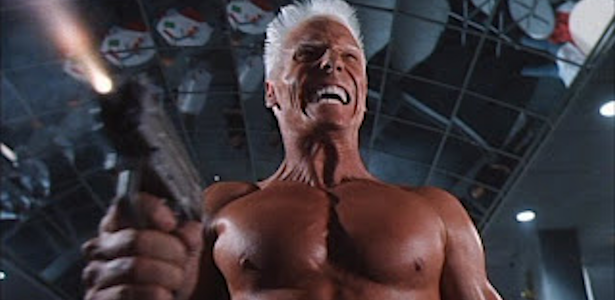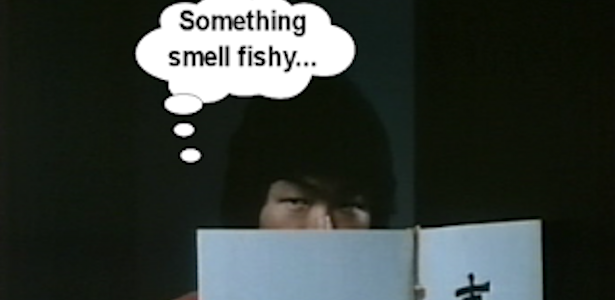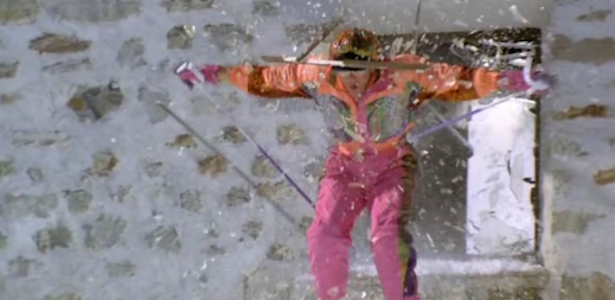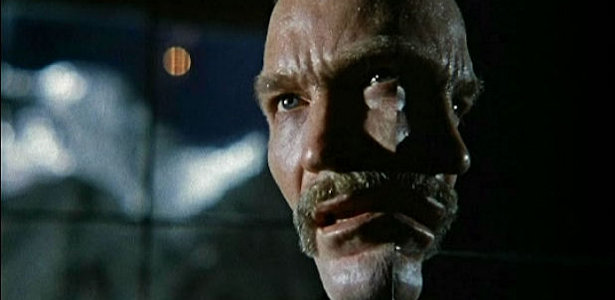 |
| Joyner directing TRANCERS III (1992) |
Having covered C. Courtney Joyner’s unmade works from the 1980s and 1990s in parts
one and
two, we now jump forward to the present to focus on some of his more recent projects. The new millennium found the always active Joyner not slowing down. In addition to scripts for television, Joyner got to write for some comics and contributed chapters to film books on Lon Chaney, Jr., John Ford and John Wayne. In 2009 he also saw the culmination of years of work with the release of THE WESTERNERS, a collection of interviews with some of the western genre's best filmmakers. Of course, he still had plenty of film ventures in the development stage at this time and in our final piece we’re going to examine three of them.
#96 - BLACK GLOVES (2005)
 |
| Promotional art for BLACK GLOVES |
This serial killer script, also know as PAPA, shows Joyner returning to his horror roots. He describes it as a “woman in jeopardy” thriller and it focuses on Kathryn, a young law student who discovers a shocking secret while trying to find her real father. She locates him but discovers he is a serial killer, who is soon captured by the F.B.I. after trying to kill her. The bad news? His long standing desire to kill was fostered by his desire to kill his own relatives and in locating him she has reenergized his drive while giving him the ultimate target. And you thought your girl had daddy issues?
Sounds like a pretty easy sell, right? Well not in Hollywood where execs want a script’s synopsis in five words or less, preferably with a similar movie mentioned (legend has it a top exec once described a project they were fond of as “like DIE HARD but set in a skyscraper”). Fighting such odds is tough, but Joyner prevailed. “BLACK GLOVES was sold to [producers] Pen Densham and John Watson a few years ago,” Joyner reveals. “They tried to get that going at MGM and didn’t.”
 |
| The end result of dealing with studios |
So what is the hold up? Would you believe something as simple as a title? When I hear a title like BLACK GLOVES, I immediately think of the 1960s/70s Italian giallo subgenre that featured black gloved killers prowling around with a razor while spying on unsuspecting heroines. “Thank you very much! That is exactly what I wanted people to think of,” Joyner exclaims with joy. “And then, of course, O.J. Simpson happened. So now everybody thinks it’s a reference to that and I go, ‘No, no, no! It’s not O.J. Simpson, it is DEEP RED.’ Say DEEP RED to a development executive and see the reaction you get.”
Indeed, chances are you say “giallo” to a studio exec and they start thinking of Bill Cosby and pudding pops. Mmmmm, pudding pops. Solving the title problem was a snap compared to the office politics: “MGM was in the process of a changing of the guard, and was sold, which is always death to a script in development, and that’s what happened with us. John and Pen are great producers, and they devoted a lot of time to the project, but everyone gets run over when studios reorganize.” Thankfully, the rights have fully reverted back to Joyner and he feels it is something that might be worth dusting off at some point.
#97 - COP WAR (2005-present)

Around the same time period, Joyner developed a script with old friend Sheldon Lettich, a screenwriter-director best known for his RAMBO III (1988) screenplay and various collaborations with Jean-Claude Van Damme. The inspiration for this contemporary action flick came from an unusual source: the 1928 Herbert Asbury non-fiction book dealing with early 20th century gangs in America’s biggest city. “I had gotten a hold of a copy – years before the Martin Scorsese movie – of the [Asbury] book THE GANGS OF NEW YORK,” Joyner discloses. “My father had a first edition of it sitting in our house forever and I read it. I was so interested in the fact that these police departments at the turn of the century in New York City basically had this shooting war going on. Most of it was ethnic – the Irish versus the Italians. Reading a lot about what was going on in L.A. – whether it was the Rodney King or even going back to the Manson investigation – there was never a lot of cooperation between the LAPD and the Sheriff’s department. I thought, ‘What if things got so bad that an actual shooting war broke out between those two facets?’”

Together the two screenwriters came up with a story of warring cop factions that, when not arresting folks, wage war over the city streets in Pittsburgh. “Sheldon had the idea that, since I’m from Pittsburgh, to set it in an urban setting and we went for Pittsburgh,” Joyner says of the plot. “A rookie policeman discovers his senior partner is involved with corruption that involves his entire precinct. When he tries to report it, he finds himself at war with his fellow officers.”
With Lettich’s Van Damme connection, it was only a matter of time before the “Muscles from Brussels” took interest in the project. “Jean-Claude Van Damme was interested in it for a while because, of course, he and Sheldon have a very good history,” he reveals. “Sheldon was always going to direct it. It’s come awfully close a few times.” One of those times was a close call as the script almost undeservedly ending up as the basis for the direct-to-video S.W.A.T. II for Sony (the world was eventually blessed with the unrelated S.W.A.T. sequel S.W.A.T.: FIREFIGHT in 2011). In 2005 a prominent director of THE WIRE also got involved, but the film was still not made.
What COP WAR almost became:
As it stands now, the script is still open for development and hopefully Lettich can get it on the front burner again. Crazy cop stories like the recent Christopher Dorner case in Los Angeles show the subject matter will always be relevant. “It’s always been an active project,” Joyner explains of the script, “and every once and a while Sheldon will call me and say, ‘Oh guess what? Somebody wants to do something with COP WAR again!’”
#98 - BOXCAR BOYS
 |
| Early 20th Century railroad camp |
It is only fitting that we end our coverage with this script as it is one of Joyner’s personal favorites, alongside DOUBLE ACTION MAN (aka WHEN A MAN LOVES A WOMAN) that John (ROLLING THUNDER) Flynn tried to get made.
Like the aforementioned COP WAR, BOXCAR BOYS also found its origin through a bit of historical research after Joyner had moved away from Hollywood for a period and was living in North Carolina. “Here is the thing I discovered – in certain states, particularly in the South, the railroad companies themselves actually owned the land and the property around where the land where tracks existed,” he details. “That is why they could have the rail hops as a private police force and nobody could do anything because, essentially, they were enforcing law on private property. You would see the pictures of the tent cities around the railroad yard during the Depression.”
 |
| Early 20th Century unsanctioned boxing match |
With this setting in place, Joyner began fashioning a scenario in the best tradition of hard hitting Depression era classics like EMPEROR OF THE NORTH (1973) and HARD TIMES (1975). “I set this in one of the tent cities and the rail hops are having boxing matches there with these guys they are essentially holding prisoner,” Joyner reveals of his script. “They capture this one kid who is sneaking on a boxcar and he’s deaf, but he’s a good fighter. And he becomes kind of famous. So the hoi polloi of the surrounding cities come in and it becomes a bigger and bigger thing. The height reaches where they have one match that brings in everybody turns into a race riot.”

With his script completed, Joyner got the labor of love to his agent and the “Jack Dempsey meets Jack London” style scenario drew immediate interest from several parties. “It got me a lot of notice,” Joyner says. “A producer got a hold of it and at different times we had Christopher Walken attached, we had Burt Reynolds attached, we had Harvey Keitel attached. All kinds of people.” One of the more fascinating interested talents was a man legendary for using his fists in real life and having been a participant in one of moviedom’s greatest fist fights in THEY LIVE (1988). “Roddy Piper really, really wanted to do it,” he reveals. “He would be playing the bad guy, which I thought would have been great. He gave me some great feedback.”
 |
| Fargo directs Chuck Norris on FORCED VENGEANCE (1982) |
Originally Joyner wrote the film with the intention of also making it his third directorial feature. However, like DOUBLE ACTION MAN, he realized a more experienced director might be in order. “Again, this really required someone a hell of a lot better than me as I’d only directed two movies now,” he says of the decision to let other directors look at it. “This was a period piece and kind of a big thing. About two or three years ago, I gave the script to James (THE ENFORCER) Fargo as we had the same agent. Jim really liked and his background with Clint Eastwood was a perfect fit. We tried to get something going at Hallmark and we couldn’t. I know Jim would still very much like to do it. I love that piece and it really attracted some good people. But, as often happens, we get the folks but couldn’t get the money. I have high hopes for that as I feel it is a real quality piece of work.”
As it stands, Joyner’s BOXCAR BOYS is still something he cherishes to this day and hopes to see made into a feature film. “You almost have a whole different feeling about that kind of work and your commitment to that work than I do with the [writing] assignments” he acknowledges regarding personal projects versus writing assigned works. “That doesn’t mean I blew anything off, but your emotional investment is a little different. There’s a little bit of difference between that and sitting in the bathtub and going, ‘Oh my God, I’ve got a great idea for a movie’ and nursing it along yourself.”
THE END?
 |
| Preproduction art for THE RETURN OF CAPTAIN NEMO |
While we’ve reached the end of our series on Mr. Joyner’s unmade screenplays, don’t think the man has any notions of slowing down. With a new year comes a myriad of new projects. On the publishing front, Joyner just saw HELL COMES TO HOLLYWOOD, a 2012 horror anthology featuring his “One Night in the Valley” short story, nominated for a Bram Stoker Award, and 2013 promises the publication of SHOTGUN, an original novel series from Kensington / Pinnacle Books, and the highly anticipated WARNER BROS. FANTASTIC, a look at the studios’ genre output from McFarland press. On the movie side, Joyner has scripted the enticing sounding THE RETURN OF CAPTAIN NEMO, which is scheduled to go into production this year. And, of course, he’ll probably get a call from Sheldon Lettich about more interest in COP WAR. As for his other unproduced works, Joyner is level headed and knows it is the nature of the game. “Every writer who's done any work in Hollywood goes through these exact same experiences,” he concludes. “My adventures aren't unusual or special at all. Unfortunately, more projects are not made than made, and it really is a case of beating the odds when something goes before the cameras. So I just keep pounding away, and hope someone takes notice.”
 SILENCERS and DARK BREED) and both are definitely recommended. One other impressive thing is he does a lot of his own stunt work. Bobby Johnston is a former Playgirl model so he was probably cast for that alone, but he is also fine as the robotic partner and the rapport with Scalia is nicely done. Evan Lurie, who is a dead ringer for WCW’s Kanyon, is also entertaining as the lead villain (although his style did lead me to wonder why a doctor would give a cyborg a pony tail). I do wish director Richard Pepin had done a bit more to establish the time period of the film though. Seriously, you can’t have anyone say a date? The closest we get is someone referring to a weapon as “vintage 20th century.” It is odd because they do a lot of things right like the cyborg designs and even little stuff like a convenience that proudly sells guns, booze and groceries. Of course, I can’t complain too much about a film that has two cyborgs break into a sex scene after they discover a nudie mag lying on the floor of their steel mill headquarters. Genius!
SILENCERS and DARK BREED) and both are definitely recommended. One other impressive thing is he does a lot of his own stunt work. Bobby Johnston is a former Playgirl model so he was probably cast for that alone, but he is also fine as the robotic partner and the rapport with Scalia is nicely done. Evan Lurie, who is a dead ringer for WCW’s Kanyon, is also entertaining as the lead villain (although his style did lead me to wonder why a doctor would give a cyborg a pony tail). I do wish director Richard Pepin had done a bit more to establish the time period of the film though. Seriously, you can’t have anyone say a date? The closest we get is someone referring to a weapon as “vintage 20th century.” It is odd because they do a lot of things right like the cyborg designs and even little stuff like a convenience that proudly sells guns, booze and groceries. Of course, I can’t complain too much about a film that has two cyborgs break into a sex scene after they discover a nudie mag lying on the floor of their steel mill headquarters. Genius!
 SILENCERS and DARK BREED) and both are definitely recommended. One other impressive thing is he does a lot of his own stunt work. Bobby Johnston is a former Playgirl model so he was probably cast for that alone, but he is also fine as the robotic partner and the rapport with Scalia is nicely done. Evan Lurie, who is a dead ringer for WCW’s Kanyon, is also entertaining as the lead villain (although his style did lead me to wonder why a doctor would give a cyborg a pony tail). I do wish director Richard Pepin had done a bit more to establish the time period of the film though. Seriously, you can’t have anyone say a date? The closest we get is someone referring to a weapon as “vintage 20th century.” It is odd because they do a lot of things right like the cyborg designs and even little stuff like a convenience that proudly sells guns, booze and groceries. Of course, I can’t complain too much about a film that has two cyborgs break into a sex scene after they discover a nudie mag lying on the floor of their steel mill headquarters. Genius!
SILENCERS and DARK BREED) and both are definitely recommended. One other impressive thing is he does a lot of his own stunt work. Bobby Johnston is a former Playgirl model so he was probably cast for that alone, but he is also fine as the robotic partner and the rapport with Scalia is nicely done. Evan Lurie, who is a dead ringer for WCW’s Kanyon, is also entertaining as the lead villain (although his style did lead me to wonder why a doctor would give a cyborg a pony tail). I do wish director Richard Pepin had done a bit more to establish the time period of the film though. Seriously, you can’t have anyone say a date? The closest we get is someone referring to a weapon as “vintage 20th century.” It is odd because they do a lot of things right like the cyborg designs and even little stuff like a convenience that proudly sells guns, booze and groceries. Of course, I can’t complain too much about a film that has two cyborgs break into a sex scene after they discover a nudie mag lying on the floor of their steel mill headquarters. Genius!































































